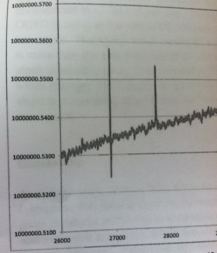Solving Oscillator Frequency Pops (Perturbation)
By Peter W. Russo, Bliley Technologies
The Problem
Oscillator frequency abruptly jumps up or down, causing a lost PLL lock or a variety of other system-related problems. The typical Frequency-vs.-Time graph of a frequency pop can be seen in the figure below.

The figure shows a frequency pop just before the 27000-second mark on the X axis. First the frequency ,pops down, going from 10000000.5340 Hz to 10000000.5250 Hz, a magnitude of 9-10. Immediately following is a frequency pop up, going from 10000000.5250 Hz to 10000000.5580 Hz, a magnitude of 33-10.
The Solution
The crystal used in the oscillator is set up to run on only one mode (the desired mode). This is accomplished through proper frequency traps (filters) and drive-level on the crystal. If something is not set up correctly, or if the drive level is too high, there is a high risk of an inharmonic mode coupling into the oscillator frequency. The drive level specification for the crystal is 65 uW and the drive level of the oscillator is unknown. Oscillator drive level was measured to be 100 uW, well above the 65 uW crystal specification. When the crystal that was used in the oscillator was tested and screened for frequency pops, none were found because the drive level was set at 65 uW. This crystal was uninstalled and tested for frequency pops using a drive of 100 uW -- the frequency pops were prevalent.
There are two solutions to this particular problem: The drive level of the oscillator can be lowered to 65 uW, or the crystal drive level specification can be raised to 100 uW. Several factors come into play when deciding which solution to pursue, such as yield and cause-and-effect. Given that this problem is very rare for the oscillator series used in this example, and that the crystal yield would not be effected, the crystal drive level specification was increased to 100 uW so crystals with frequency pops at this drive level could be rejected in test.
Conclusion
The drive level specification for the crystal must be the same as -- or close to -- the actual oscillator drive level.
